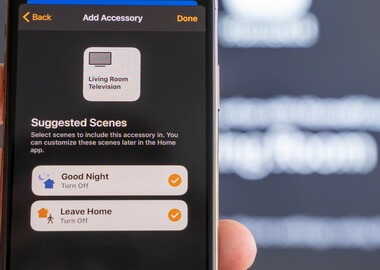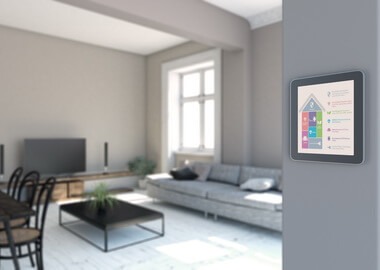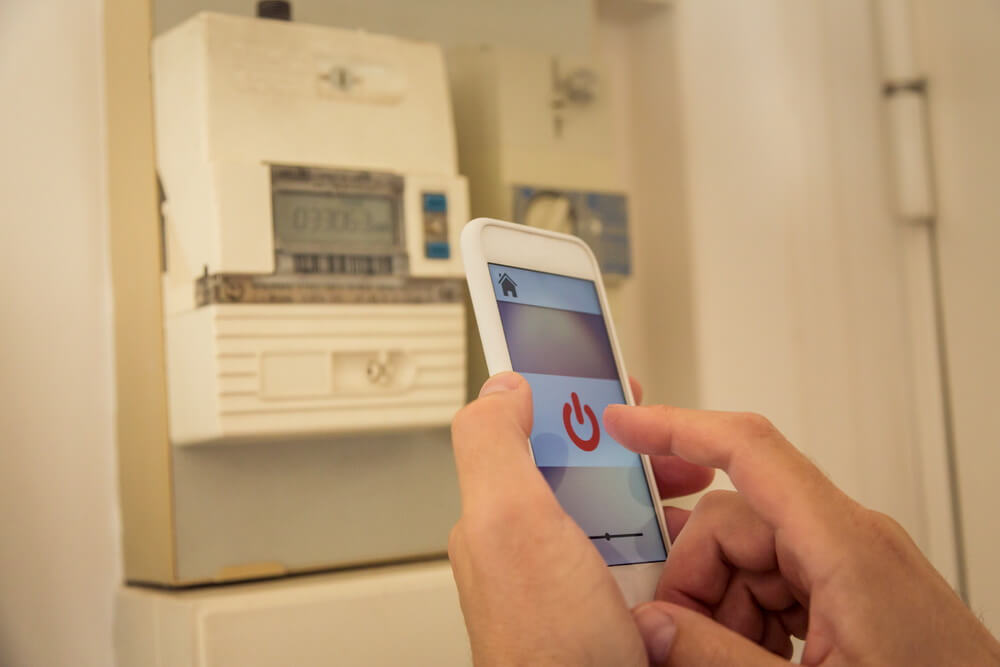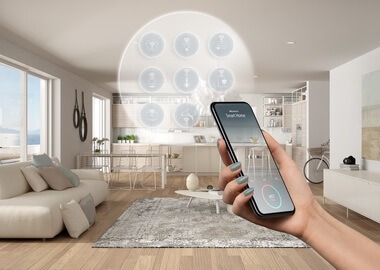How to Create a Smart Home Application for Home Automation
Global smart home market shows steady gains no matter what, and no pandemic or erupting volcano seems to stop it. Strategy Analytics predicts that, despite a slight slowdown in 2020, this sector will add about 15% CAGR each year.
This growth explains the increasing demand for smart home app development. If there is a smart device, there is an app to configure, control and monitor it. Anyone who steps into this niche will think about building a smart home app, at some point.
In this article, we will talk about the essentials of smart home apps and give practical advice on strategy, design and development.
Evolution of devices and customer expectations
We are used to the fact that the new generation of home appliances and the whole infrastructure, including ventilation and lighting, are getting connected and smart. Customers expect to get more intelligent goods, and the market responds. Meanwhile, smartphones work as one-stop access points to control and monitor all these gadgets and gizmos.

Availability of hardware components
It’s cheaper and easier to build smart home prototypes, experiment with functionality and connectivity and create smart home MVPs than, say, 10 years ago. IoT hardware market is booming. Microchips, sensors, boards, components and ready-to-use kits are diverse and getting increasingly affordable and accessible.
Expansion of cloud providers and services
Could services are rapidly expanding both in quantity and quality. There are major IoT Cloud platforms by Amazon, Google and Microsoft that offer all-in-one solutions for data analytics, security, network and device management. They are incredibly flexible in terms of customization and pricing. And there are smaller players in the market like Blynk or Upswift that help kickstart IoT projects on budget or at no cost at all.
Environmental standards and regulations
Certain categories of smart home systems such as smart electricity meters play important role in local and national programs for environmental protection. Adoption of these technologies is no longer optional in the countries like the UK and the US. Other forward-looking countries like the Netherlands, for example, pioneer the concept of smart districts where home automation technology is integrated into every single household.
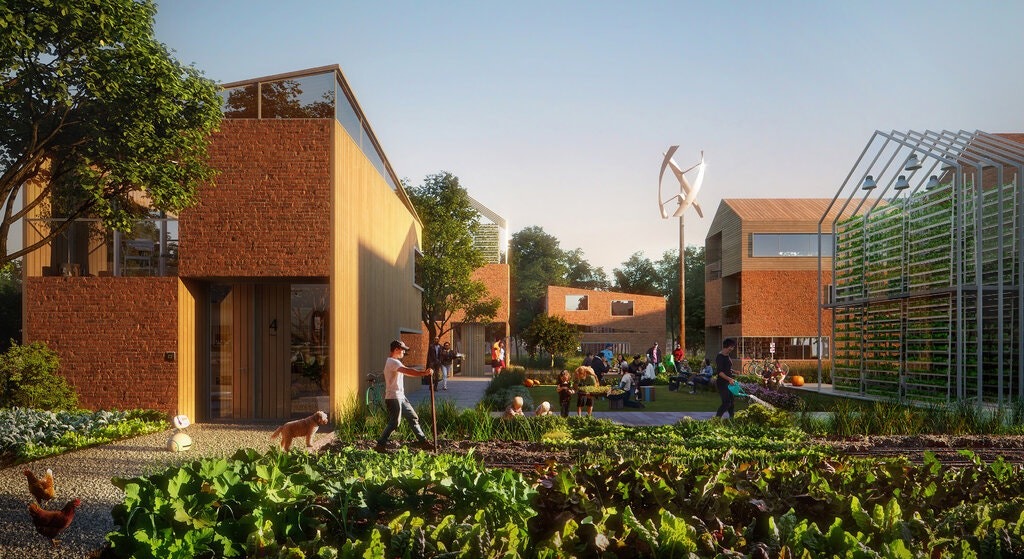
Brainport Smart District rendering. Image credit: UNStudio
Market value
Demand for home automation app development is inherently linked with the surging investment into the smart home market. According to Statista, this sector will double its value by 2025 and reach $88 billion compared to $44 billion in 2020 and expected $62 billion in 2021. Companies, big and small, show interest in varied areas of this eclectic market, from critical smart home security and networking solutions to futuristic household robots.
The new normal
It wouldn’t be right not to mention the role of home automation in the new normal we found ourselves after 2020. Xiaomi has recently rolled out the results of the survey (US) which says that more than half of consumers who did remodeling in 2020 bought at least one smart home device. Throughout 2020 and now in 2021, we have been forced to work, study and socialize mostly from home, and many say the habits of the pandemic will stick. The role of smart home tech will only increase and help us make our homes more comfortable, sustainable and secure.
Are you looking for smart home applications development team to help you deliver and put your product to the market faster? We might have just the right competence. Let’s get in touch!
Contact Digiteum
The market of smart home products and applications is diverse and will only proliferate in the future. Some of the most popular categories of products are:
- HVACR systems for heating, ventilation, air conditioning and refrigeration are some of the most popular among consumers (thermostats, air purifiers, etc.)
- Energy management systems (circuits, off-grid systems, energy storage, etc.)
- Security (locks, camera-enabled doorbells, surveillance, etc.)
- Lighting (bulbs, switches, shaders, etc.)
- Health and wellness (scales, fitness mirror, etc.)
- Home appliances and furniture (fridge, vacuum cleaner, bed, wardrobe, etc.)
- Virtual assistants and robot companions (Alexa in Amazon Echo, Kuri robot, etc.)
Most of these products are paired with mobile applications for configuration, remote control, monitoring and automation. Depending on the functionality, category and producer, it can be a standalone single-task application or an app for the whole category of devices such as Health or Home.
One app for one device
This is a good choice for a brand that specializes in one type of smart home device. For example, iRobot, producer of premium-class robot vacuum cleaners we all know as Roomba, pairs its smart vacuums and mops with one feature-rich mobile application — iRobot Home App.
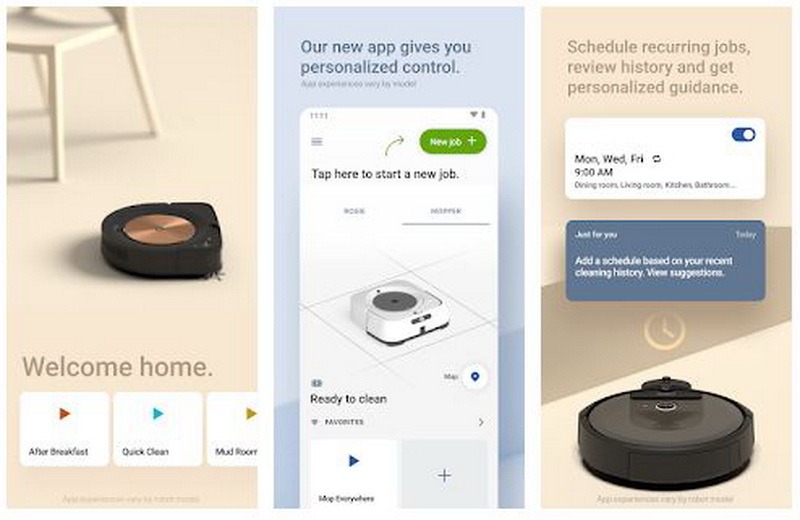
iRobot Home App on Google Play. Image credit: iRobot
One app for a category of devices
Alternatively, companies that produce a range of smart home products often allow users to get one multitasking app for the whole category of devices. A good example is Nest app for Nest products. Not only does this approach creates a better experience for users, but also helps reduce smart home app development cost by scaling an app instead of building a myriad of new ones.
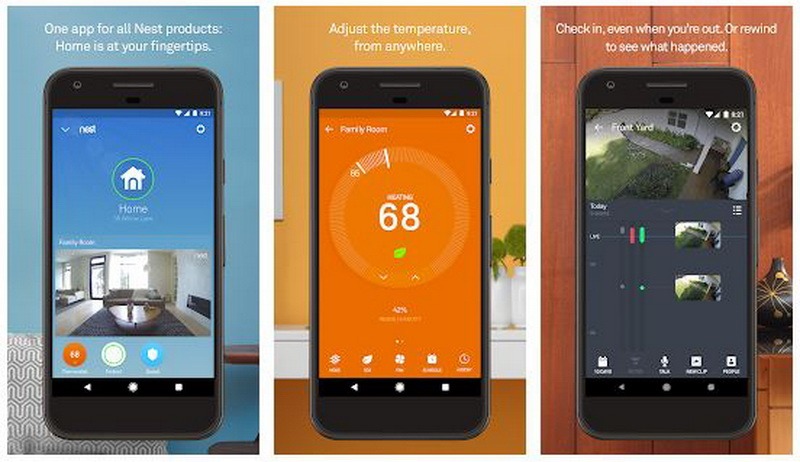
Nest app on Google Play. Image credit: Nest
All-in-one application for hubs
Hubs are standalone solutions. They unite cross-category and cross-brand devices around the house and work as a one-stop control and automation point. Good examples are Amazon Echo devices with Amazon Alexa app or Smart Things Hub with SmartThings app that allows you to connect hundreds of devices in one place.
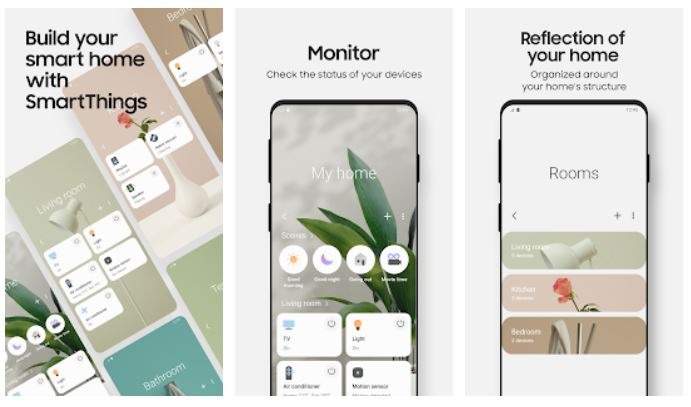
SmartThings app on Google Play. Image credit: Samsung
Many design and tech stack choices in home automation application development depend on the type, category and, importantly, desired functionality of a smart home system.
In the next section, we’ll talk about the common features that people usually expect to see in their smart home apps.
Onboarding and set-up
Onboarding helps a customer make the first steps in using a new device — set it up, put it online, create an account and understand how the app works. Mobile app is just the right tool for this purpose. Most smart home products have a few basic buttons and a small display or no display at all, so there’s not much room for maneuver. Modern smartphones, on the contrary, provide endless possibilities to make onboarding fast and effortless.
User roles
One of the most important app features for smart home systems is the distribution of user roles. It is crucial for security systems and locks, which require vigilance and special attention to who has access to the application and data. However, this feature is useful in many other gadgets which may have multiple users around the household and require different permissions and roles (e.g. admin, user, host, guest, etc.).
Notifications
Push notifications are extremely useful if designed and configured right, or extremely annoying otherwise. This is why many truly smart smart systems allow customizing notifications depending on their urgency and value.
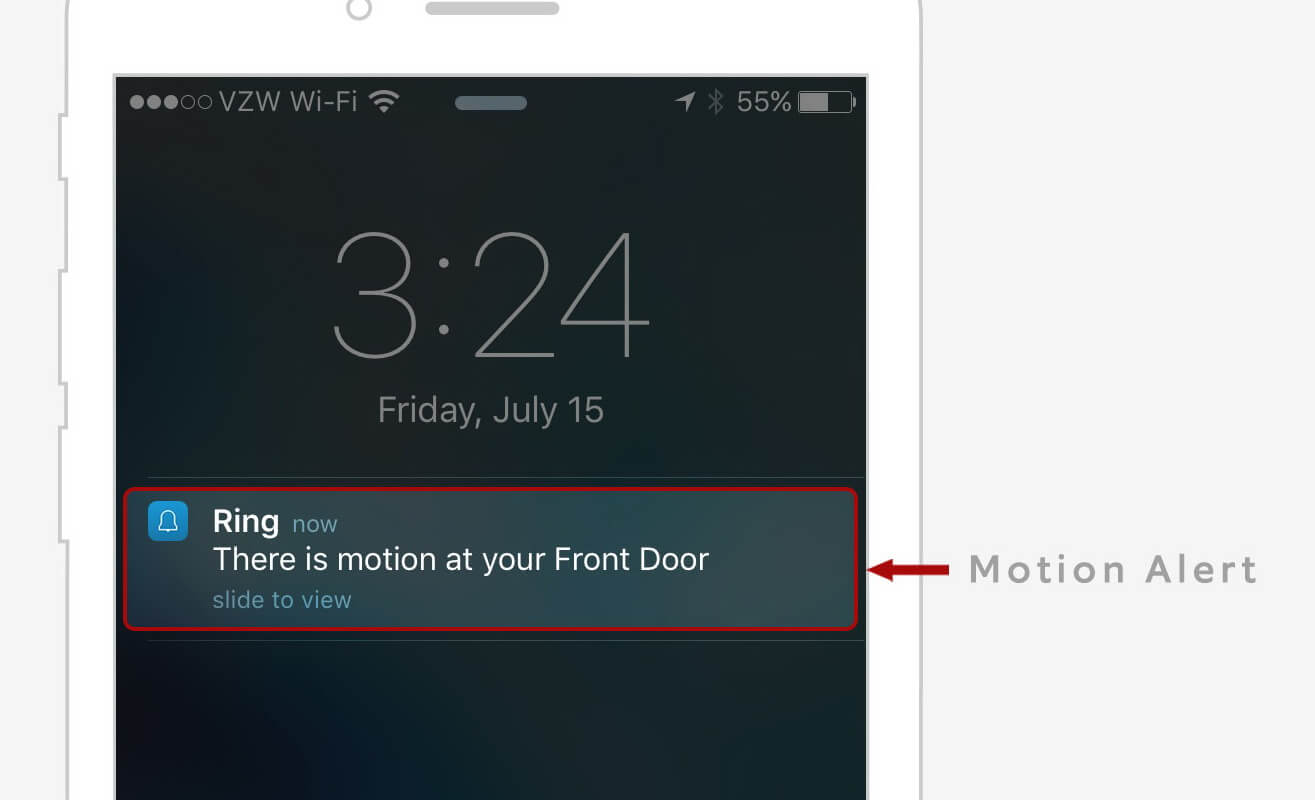
Alert notification. Image credit: Ring
Remote control and automation
Remote control allows users to manipulate their devices using a mobile app when they are in or out of home. It is convenient when they need, for example, to prewarm the house before getting back from vacation or unlock the front door remotely. Automation features take it to the other level. It allows users to program regimes or build up routines based on the usage data and thus frees users from the need to control anything in the long run.
Monitoring and reports
One of the best things about an intelligent home is that all these gizmos collect data using sensors and know how to act on it. Mobile applications give access to some of this data to end-users, visualize it to make it easy to read, build reports, etc. Interestingly, analytics features add value in some cases (e.g. weight monitoring in smart scale app) and become the center of the whole app in others (e.g. energy management system).
When you know what type of application you are looking for and have an idea about the features you need for a start, you can start thinking about how to develop a smart home automation app. Let’s talk about it in the next section.
So how do you create a smart home app? Fundamentally, the process is more or less standard for mobile app development. It includes:
- Research (Discovery phase if needed)
- UX/UI design
- Development
- Delivery and optimization
However, you should keep in mind that almost every smart home system is multicomponent. There is an actual physical device, network and connectivity components, cloud-based data management. And this has an impact on every stage of the development process.
We won’t go into detail about how mobile apps are built in general, you can read about it in the article listed below. Instead, we’ll talk about the specifics of custom smart home app development at different stages.
Research and Discovery phase
If you are at the idea stage of your product, you may want to kick off with a Discovery phase to study your audience and market, gather requirements and figure out a product development strategy. And even with a ready or nearly-ready device on hand, you need to start the smart home app development process with research. Information you gather during the research stage will help you choose the right platform (native iOS or Android, cross-platform), tech stack, design approach and set clear goals and priorities.
Apart from traditional audience, competitor, market and technology analysis, you need to consider the specifics of your hardware, network, power requirements, data volume, etc. It will help you decide how to design and build certain app features and components (e.g. onboarding, notifications, data dashboards). It will also determine what integrations, cloud services and security tools you may need to engage to keep your system safe and high-performing.
Design
Design for IoT applications has its own peculiarities, and we talked about it earlier in the article How to design IoT apps. Smart home apps are no exception.
To build a good user experience, you generally take into account many factors such as user goals, design trends and industry best practices. Additionally, you have to consider the physical environment and the device itself. UX must be consistent and yet personalized on all devices. Ideally, controlling a smart home device remotely on a mobile app should be as easy and enjoyable as doing so manually using the only 2 buttons it has. The same goes for interface design. Both look and feel should match.
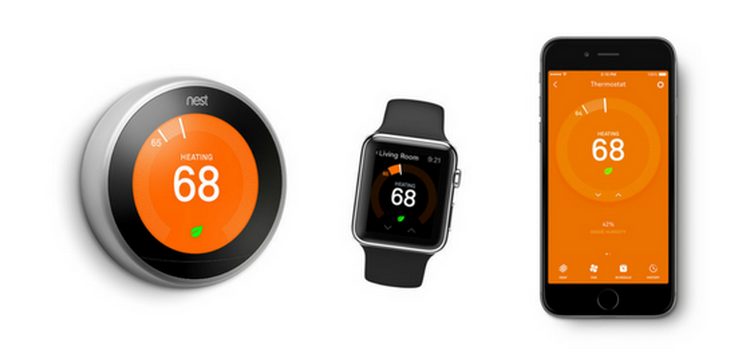
Consistent design on a smart device, smartwatch and mobile app. Image credit: Nest
Development and testing
There’s a high chance you will have to engage your device in the app development and testing process. For instance, if end-users are supposed to configure the network, set up a device and make it synch with other devices via a mobile app, engineers need to be able to connect to the device locally and use it while working on this functionality, testing and debugging.
They may use different connectivity and protocols to put the device online (e.g. Bluetooth) or even set up offline mode for development and testing. Eventually, a finished mobile app will mostly communicate with the device via a cloud-based backend, and the device itself may use other connectivity options (WiFi, Zigbee, Z-Wave, etc.) to send data to the cloud and communicate with other systems.
So if you ask if any mobile developer can build an app for home automation system, the short answer will often be ‘no’. You need engineers who know a thing about hardware, can engage different tools, SDKs and protocols to connect to it and figure our relevant test cases.
Wondering how to make an app for your smart home system? We have hands-on experience working with smart home systems and teams for full-cycle mobile app development. Let’s talk and see how we can help implement your business idea.
Contact Digiteum
Launch and post-launch
You will probably launch your smart home device and app simultaneously given that most of the time one can’t work without the other one. Depending on the platform, you may have to wait a couple of days before the app is approved and added to stores. Once it’s approved, prepare for even more adventurous journey of monitoring, optimization and updates.
If both your device and app are at the beta testing phase, it means for the next few months you will be gathering data and user feedback to see how your product is doing and plan further steps. Expect that your app will evolve together with the physical product.
And let’s not forget that you don’t build a smart home app for simply turning devices on and off remotely. This is a place where you can stretch the capabilities of your system and put all the cool features — analytics, custom modes, automation, integration with related services, etc. Many of these features and other perks will get to the next versions of your application.

We have practical experience in custom smart home application development and a huge mobile app portfolio across other domains.
- In 2019, we have built a natively-compiles cross-platform application for our US-based client — a smart home and cleantech innovator. Check the case study for this project here.
- Apps we have launched are featured on stores and received awards and recognition from Apple, NESTA, PR NEWS, WebHealth and others.
- We have built dozens of mobile applications for successful startups and enterprise-level clients: smart home and utility apps, wearable companions, logistics apps, photo, edtech and mHealth applications, etc.
- Our teams design and develop native and cross-platform applications of any complexity.
So if you are looking for engineers with experience at the crossroads of IoT, mobile and smart home, you have just found them. We can augment your development team if you search for extra competence or need to speed up to meet a tight deadline. Or we can build a project from zero. Let’s talk to find out how we could help.
A few words to wrap it up
You saw the numbers. The market of smart home already has solid ground, and yet it is still emerging. There is a vast potential to explore and many business opportunities to hop on to.
We are far from having a seamless smart home experience, despite having hubs, families of devices, better connectivity and integration than 5 years ago. Mobile technologies, cloud platforms, evolving hardware and next-gen interfaces will play an important role in paving this road and building fully automated intelligent homes. Meanwhile, startups, IoT companies and the big tech who will be able to find the right features, deliver in time and proactively respond to user needs will be the ones to shape this market in the future.


